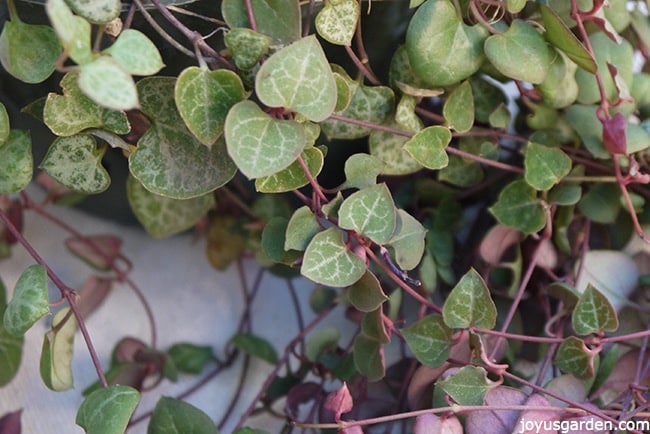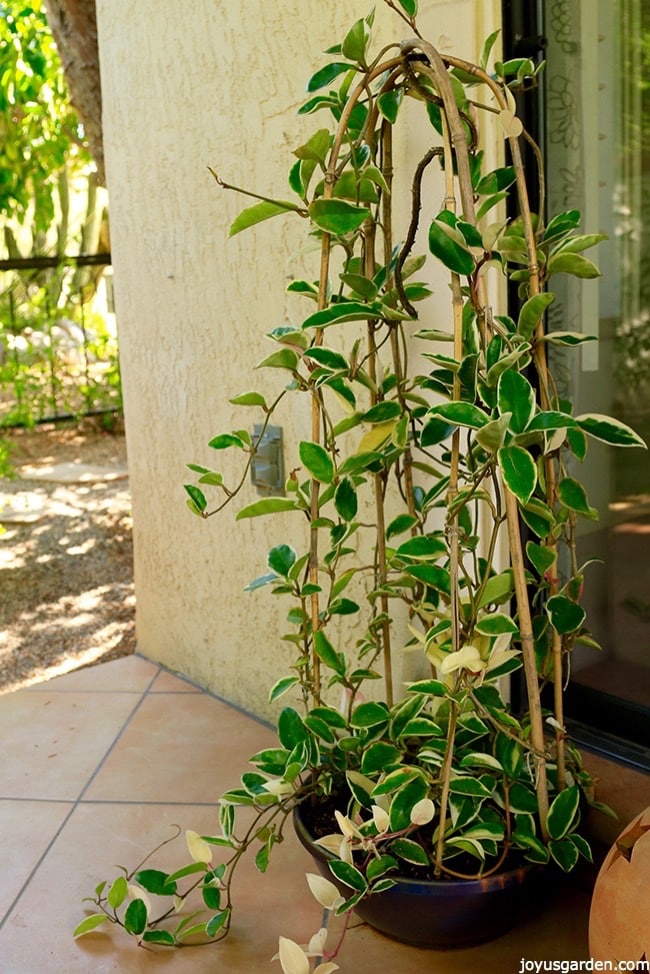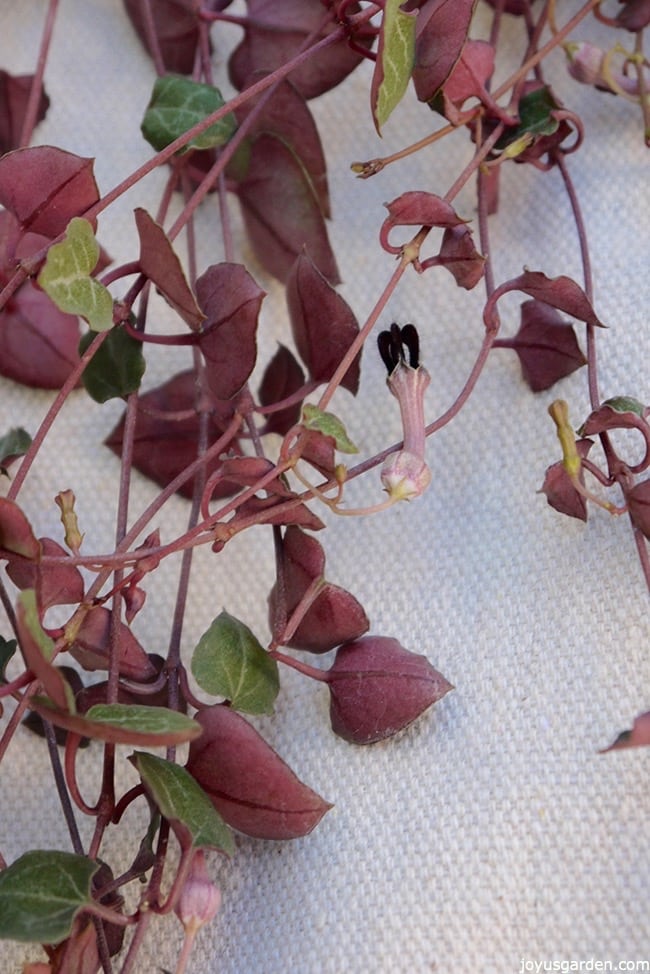如何种植一串红:一种甜美的多肉类蔓生家庭盆栽植物

Table of contents

哦,可爱的小心弦,很多人都以为你是多肉植物,其实你不是。这种蔓生家庭盆栽耐久性强,养护简单,与多肉植物相似,但它与我喜欢的另一种植物霍亚(Hoya)同属一个家族。 它们都被认为是多肉藤本植物。
它的植物学名称是 Ceropegia woodii,但也叫玫瑰藤或 Chain Of Hearts。
 本指南
本指南 我的 "红心串 "的表亲 "Hoya "长得非常快,很快就该重新栽种了。
当我从圣巴巴拉搬到图森的时候,我发现了这种不寻常的美丽植物,它的叶子呈心形,因此得名。 在我住在这里的 4 个月里,这种植物(挂在我的粉红柚子树上)长得非常快。 它们的蔓都长约 12 英寸,现在最长的有 43 英寸。 我很快就发现玫瑰藤喜欢高温!
玫瑰藤喜欢高温,但不喜欢阳光直射。
虽然健康的 "心之串 "茎叶繁茂,但并不像藤本植物那样枝繁叶茂。 它的枝叶比较稀疏,但这一点以及花朵是它吸引人的重要原因。 我的 "心之串 "在开往新家的 9 小时 "满载植物的车程 "中被缠绕得无药可救,所以就一直缠绕着。 虽然缠绕着,但它的表现还不错。
下面是一些关于玫瑰藤的知识:
尺寸
玫瑰藤的蔓在自然状态下可以长达 12 英尺。 通常作为家庭盆栽种植时,它的长度不会超过 2 英尺。 我的玫瑰藤长在室外,现在已经长到 4 英尺了。
曝光:
在室内,要给它非常明亮的光线,不要让阳光直射。 西面的窗户也可以,但要确保它不对着灼热的玻璃。 在室外,我把它放在明亮的树荫下,不要让阳光直射,它就长在我的粉红柚子树下。
水
作为家庭盆栽,您希望 String Of Hearts 在两次浇水之间干透。 我说过,这种植物严格来说不是多肉植物,但您要像对待多肉植物一样对待它。 在沙漠的炎热夏季,我每隔一天就浇一次水,但现在是十月(最高气温在 90 度左右)& 我已经减少到每 3-5 天浇一次水。 给它太多的水& 就和它说再见吧!
See_also: 凤头日本燕窝蕨养护技巧重要提示:冬季浇水更少,因为玫瑰藤会进入休眠期。

我的心之弦》是一部追踪机器!
耐寒性
我的那只住在圣巴巴拉的室外,那里冬天的气温能降到华氏 30 多度到 40 多度。我在某处读到它能耐寒到华氏 25 度,所以我打算把它放在图森和坎普的室外,看看会发生什么。
土壤
多肉植物和仙人掌的混合物就可以了。 如果你有椰糠,你的 String Of Heats 会很喜欢的。 或者,一半蕙兰和一半多肉植物的混合物也可以。 只要确保混合物排水良好。
移植:
最好在春季或夏季移植玫瑰藤。
肥料:
像我种植的大多数植物一样,我在春天用蚯蚓粪给它们施肥。 如果你觉得你的植物需要施肥,那么在春天施用均衡的液体植物肥料也是可以的。
鲜花
是的!我的花从夏末就开始开花了,而且花开得越来越多。

这就是那些可爱又有趣的小花。
修剪:
不需要修剪太多,我只剪掉了一些枯茎。 如果你的茎变得粗壮,或者你想扦插繁殖,那就需要修剪。
传播:
最简单的方法是茎插&将块茎直接放在混合物上。 它们很快就能生根。
害虫
注意蚜虫和鳞片。
玫瑰藤给人们带来麻烦有两个原因:光照不足;或水太多,尤其是在冬季。
红心串或玫瑰藤是一种很好的蔓生家庭盆栽植物。
在温暖的气候条件下,您可以全年在室外种植它。 它还有一种变种,带有淡淡的粉色。 我打算把它种在一个大吊篮里,与 "珍珠串"(String Of Pearls)和 "香蕉串"(String of Bananas)一起种植。 请继续关注我们的文章和视频!
快乐园艺

只是因为......一只蝴蝶正在享受我的红色天堂鸟。
See_also: 修剪让丹参恢复活力如果你喜欢蔓生多肉植物,那么可以试试鱼钩菊,它非常容易种植!
您可能还会喜欢
7 种令人喜爱的悬挂式多肉植物
多肉植物需要多少阳光?
应该多久给多肉植物浇一次水?
多肉植物和仙人掌花盆用混合土
如何将多肉植物移栽到花盆中
芦荟 101:芦荟植物护理指南综述
本文章可能包含联盟链接。 您可以在此阅读我们的政策。 您购买产品的成本不会增加,但 Joy Us garden 会收取少量佣金。 感谢您帮助我们传播信息 & 让世界变得更美丽!

